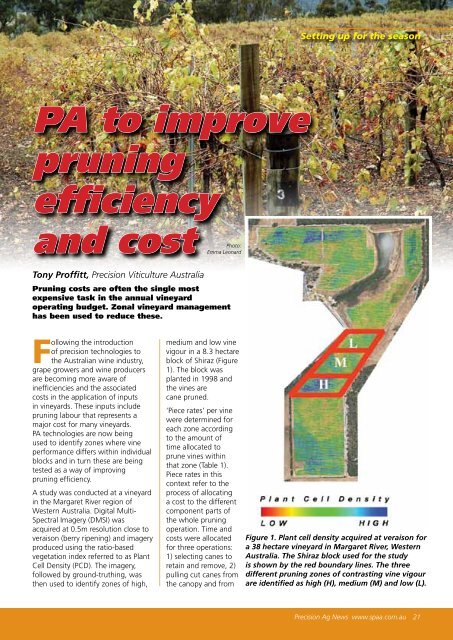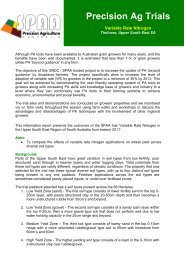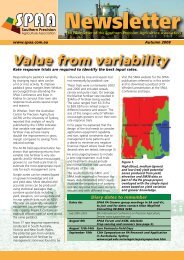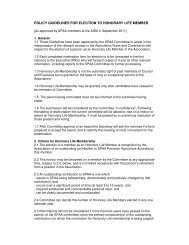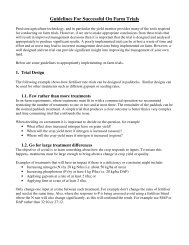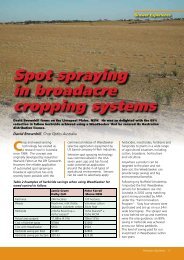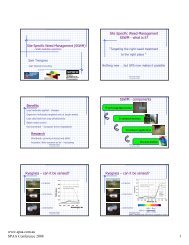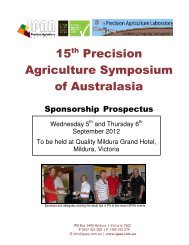PA to improve pruning efficiency and cost - SPAA
PA to improve pruning efficiency and cost - SPAA
PA to improve pruning efficiency and cost - SPAA
You also want an ePaper? Increase the reach of your titles
YUMPU automatically turns print PDFs into web optimized ePapers that Google loves.
Setting up for the season<br />
<strong>PA</strong> <strong>to</strong> <strong>improve</strong><br />
<strong>pruning</strong><br />
<strong>efficiency</strong><br />
<strong>and</strong> <strong>cost</strong><br />
Tony Proffitt, Precision Viticulture Australia<br />
Pho<strong>to</strong>:<br />
Emma Leonard<br />
Pruning <strong>cost</strong>s are often the single most<br />
expensive task in the annual vineyard<br />
operating budget. Zonal vineyard management<br />
has been used <strong>to</strong> reduce these.<br />
Following the introduction<br />
of precision technologies <strong>to</strong><br />
the Australian wine industry,<br />
grape growers <strong>and</strong> wine producers<br />
are becoming more aware of<br />
inefficiencies <strong>and</strong> the associated<br />
<strong>cost</strong>s in the application of inputs<br />
in vineyards. These inputs include<br />
<strong>pruning</strong> labour that represents a<br />
major <strong>cost</strong> for many vineyards.<br />
<strong>PA</strong> technologies are now being<br />
used <strong>to</strong> identify zones where vine<br />
performance differs within individual<br />
blocks <strong>and</strong> in turn these are being<br />
tested as a way of improving<br />
<strong>pruning</strong> <strong>efficiency</strong>.<br />
A study was conducted at a vineyard<br />
in the Margaret River region of<br />
Western Australia. Digital Multi-<br />
Spectral Imagery (DMSI) was<br />
acquired at 0.5m resolution close <strong>to</strong><br />
veraison (berry ripening) <strong>and</strong> imagery<br />
produced using the ratio-based<br />
vegetation index referred <strong>to</strong> as Plant<br />
Cell Density (PCD). The imagery,<br />
followed by ground-truthing, was<br />
then used <strong>to</strong> identify zones of high,<br />
medium <strong>and</strong> low vine<br />
vigour in a 8.3 hectare<br />
block of Shiraz (Figure<br />
1). The block was<br />
planted in 1998 <strong>and</strong><br />
the vines are<br />
cane pruned.<br />
‘Piece rates’ per vine<br />
were determined for<br />
each zone according<br />
<strong>to</strong> the amount of<br />
time allocated <strong>to</strong><br />
prune vines within<br />
that zone (Table 1).<br />
Piece rates in this<br />
context refer <strong>to</strong> the<br />
process of allocating<br />
a <strong>cost</strong> <strong>to</strong> the different<br />
component parts of<br />
the whole <strong>pruning</strong><br />
operation. Time <strong>and</strong><br />
<strong>cost</strong>s were allocated<br />
for three operations:<br />
1) selecting canes <strong>to</strong><br />
retain <strong>and</strong> remove, 2)<br />
pulling cut canes from<br />
the canopy <strong>and</strong> from<br />
Figure 1. Plant cell density acquired at veraison for<br />
a 38 hectare vineyard in Margaret River, Western<br />
Australia. The Shiraz block used for the study<br />
is shown by the red boundary lines. The three<br />
different <strong>pruning</strong> zones of contrasting vine vigour<br />
are identified as high (H), medium (M) <strong>and</strong> low (L).<br />
Precision Ag News www.spaa.com.au 21
Setting up for the season<br />
Table 1. Piece rates <strong>and</strong> <strong>to</strong>tal <strong>pruning</strong> <strong>cost</strong>s in a 8.3 hectare block of Shiraz using both zonal <strong>and</strong> uniform<br />
management methods.<br />
Pruning<br />
method<br />
Vine<br />
number<br />
Lopping Pulling Wrapping Total <strong>pruning</strong><br />
<strong>cost</strong>/vine# <strong>cost</strong>/vine* <strong>cost</strong>/vine+ <strong>cost</strong><br />
($) ($) ($) ($)<br />
Uniform 12,445 0.42 0.40 0.85 20,783.15<br />
Zonal<br />
High vigour 2,578 0.44 0.42 0.92 4,588.84<br />
Medium vigour 5,562 0.37 0.35 0.76 8,231.76<br />
Low vigour 4,305 0.31 0.30 0.68 5,553.45<br />
Total 18,374.05<br />
# refers <strong>to</strong> the <strong>cost</strong> of selecting canes <strong>to</strong> retain <strong>and</strong> cutting the canes <strong>to</strong> remove.<br />
* refers <strong>to</strong> the <strong>cost</strong> of pulling the cut canes out from the canopy <strong>and</strong> foliage wires.<br />
+ refers <strong>to</strong> the <strong>cost</strong> of cutting the retained canes <strong>to</strong> the correct number of buds <strong>and</strong> wrapping the canes <strong>to</strong> the<br />
fruiting wire.<br />
the foliage wires, 3) cutting canes<br />
<strong>to</strong> the required bud number <strong>and</strong><br />
wrapping canes <strong>to</strong> the fruiting wire.<br />
Each person was free <strong>to</strong> work as<br />
fast or as slow as they wished since<br />
each ‘piece’ completed was paid at<br />
a set rate. The faster the opera<strong>to</strong>rs<br />
worked, whilst maintaining a certain<br />
quality of work, the more money<br />
they made. All opera<strong>to</strong>rs needed <strong>to</strong><br />
be able <strong>to</strong> prune an equal number<br />
of vines of varying vigour, <strong>and</strong> hence<br />
degree of difficulty.<br />
The benefit of using the PCD<br />
imagery before <strong>pruning</strong> started<br />
was that opera<strong>to</strong>rs could be given<br />
a certain number of ‘easy’ <strong>and</strong><br />
‘hard’ rows <strong>to</strong> prune so that it was<br />
fair <strong>to</strong> all. After <strong>pruning</strong> had been<br />
completed in the block, the <strong>to</strong>tal<br />
<strong>cost</strong> of the operation using the <strong>PA</strong><br />
zonal management approach was<br />
compared <strong>to</strong> the <strong>to</strong>tal expected<br />
<strong>cost</strong> had the traditional uniform<br />
management approach of <strong>pruning</strong><br />
been implemented.<br />
The <strong>cost</strong> using the uniform<br />
management approach is<br />
approximate since this methodology<br />
was not actually implemented.<br />
However, it is estimated that there<br />
was a <strong>cost</strong> saving of approximately<br />
$2,400 (11.6 per cent) by<br />
implementing a <strong>PA</strong> zonal <strong>pruning</strong><br />
management approach. In addition,<br />
all <strong>pruning</strong> staff made similar<br />
amounts of money, which ensured<br />
that morale remained high <strong>and</strong><br />
staff truancy remained low which<br />
enabled the <strong>pruning</strong> operation <strong>to</strong><br />
be completed within the required<br />
time period.<br />
For more information<br />
Tony Proffitt, AHA Viticulture/<br />
Precision Viticulture Australia,<br />
<strong>to</strong>ny@ahaviticulture.com.au<br />
On the 8.3 hectare Shiraz block used in the trial, <strong>pruning</strong><br />
<strong>cost</strong>s were reduced by 11.6 per cent by allocating areas<br />
<strong>to</strong> each pruner by zone rather than uniformly.<br />
Pho<strong>to</strong>: Emma Leonard<br />
22 Precision Ag News www.spaa.com.au


